Abstract
Substantial progress has been made in understanding the genetic basis of temperature-compensated circadian clocks. Ultradian rhythms, with a period shorter than 24 h, are at least as widespread as circadian rhythms. We have initiated genetic analysis of defecation behavior, which is controlled by an ultradian clock in Caenorhabditis elegans. The defecation motor program is activated every 45 sec, and this rhythm is temperature compensated. We describe mutations in 12 genes that either shorten or lengthen the cycle period. We find that most of these mutations also disrupt temperature compensation, suggesting that this process is an integral part of the clock. These genes open the way for molecular genetic dissection of this ultradian clock.
Full text
PDF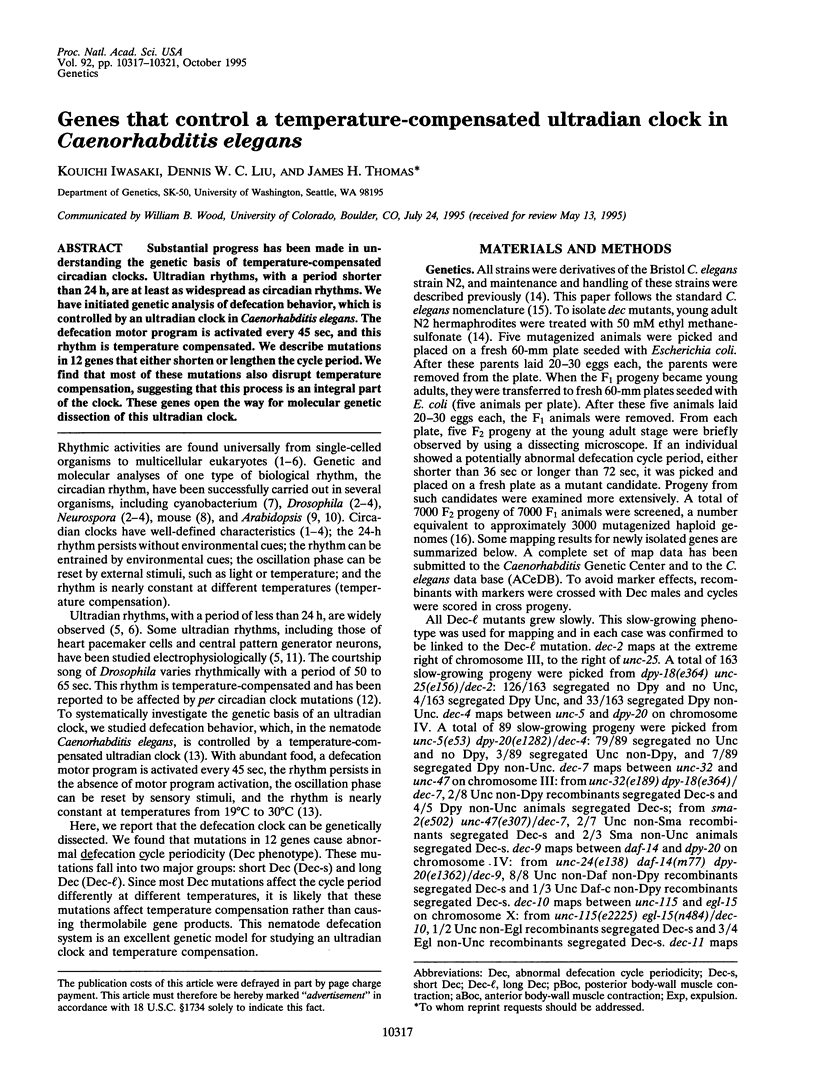
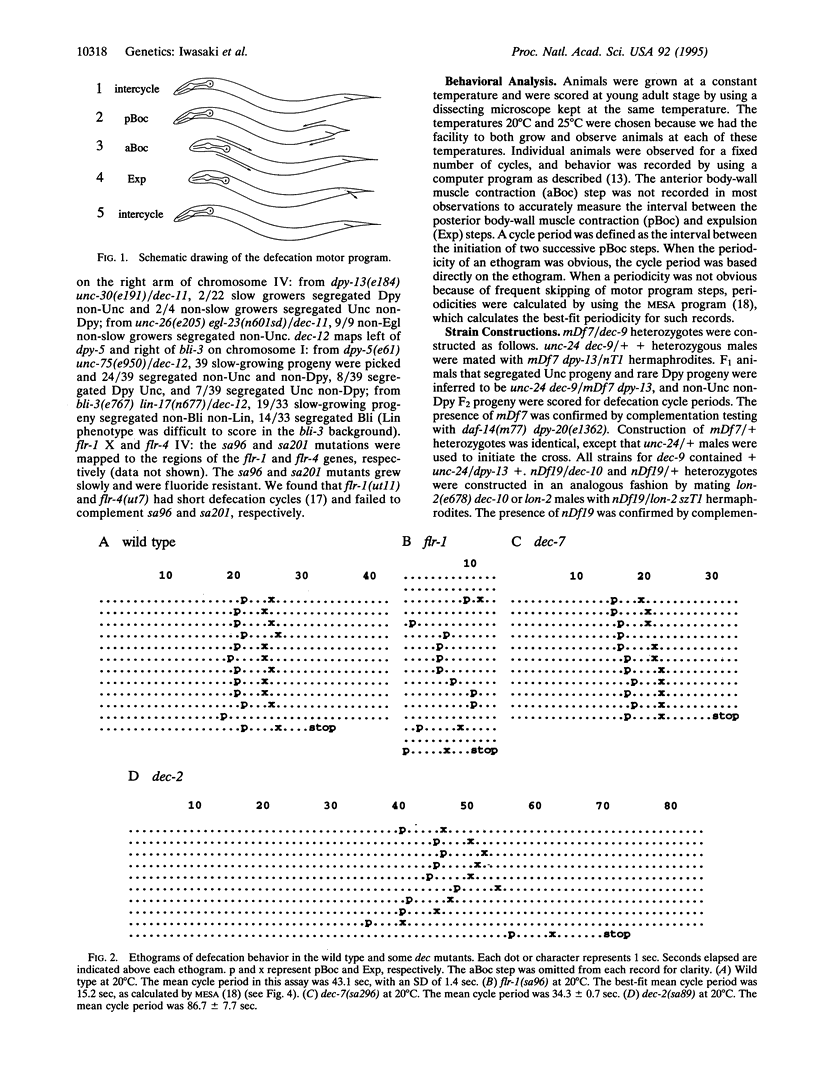
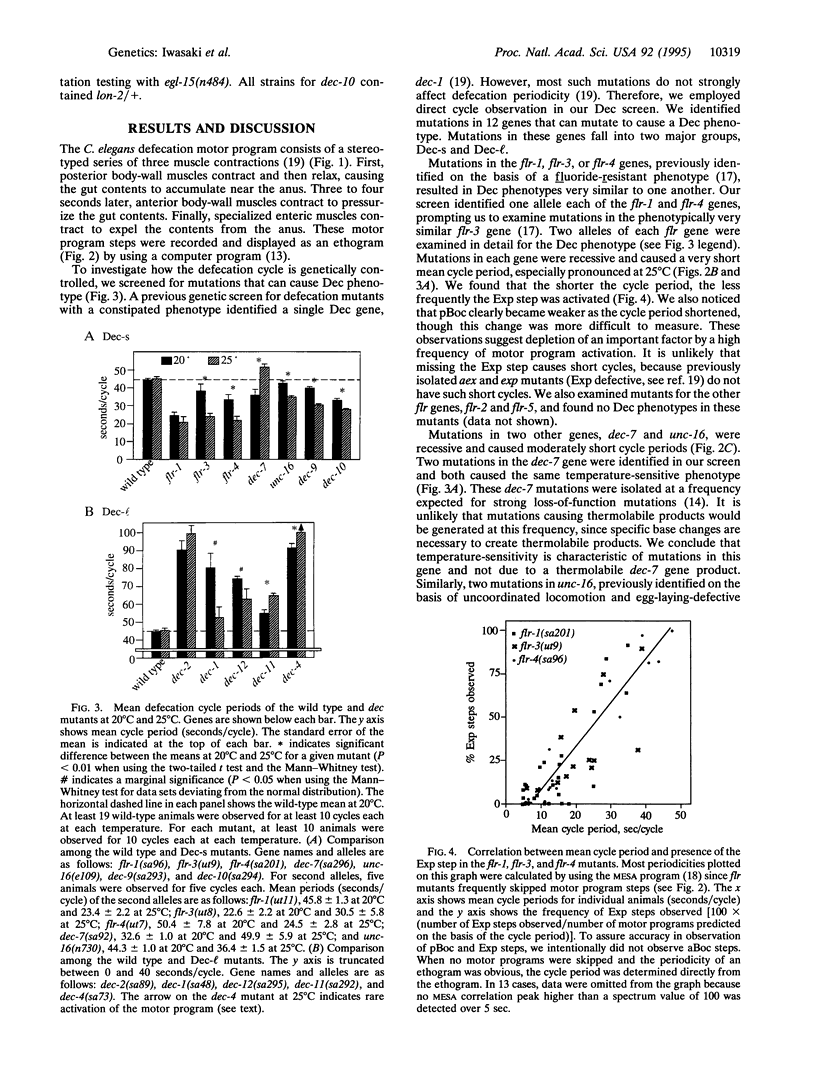
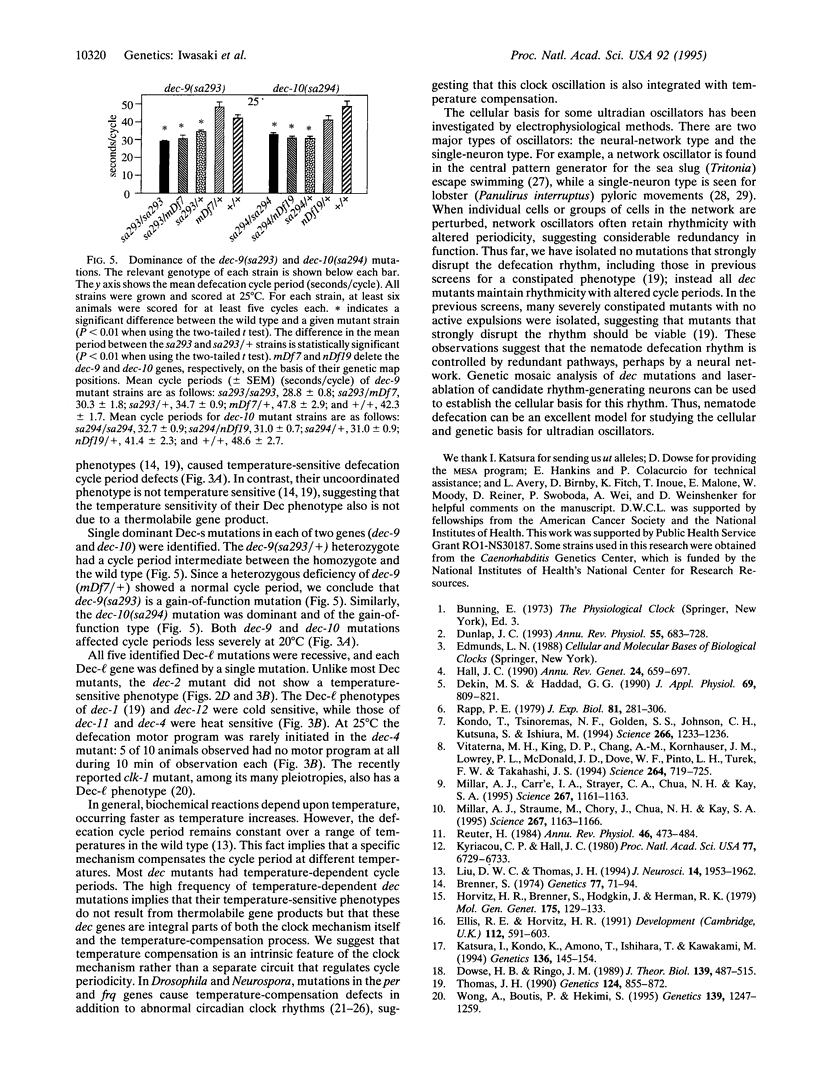
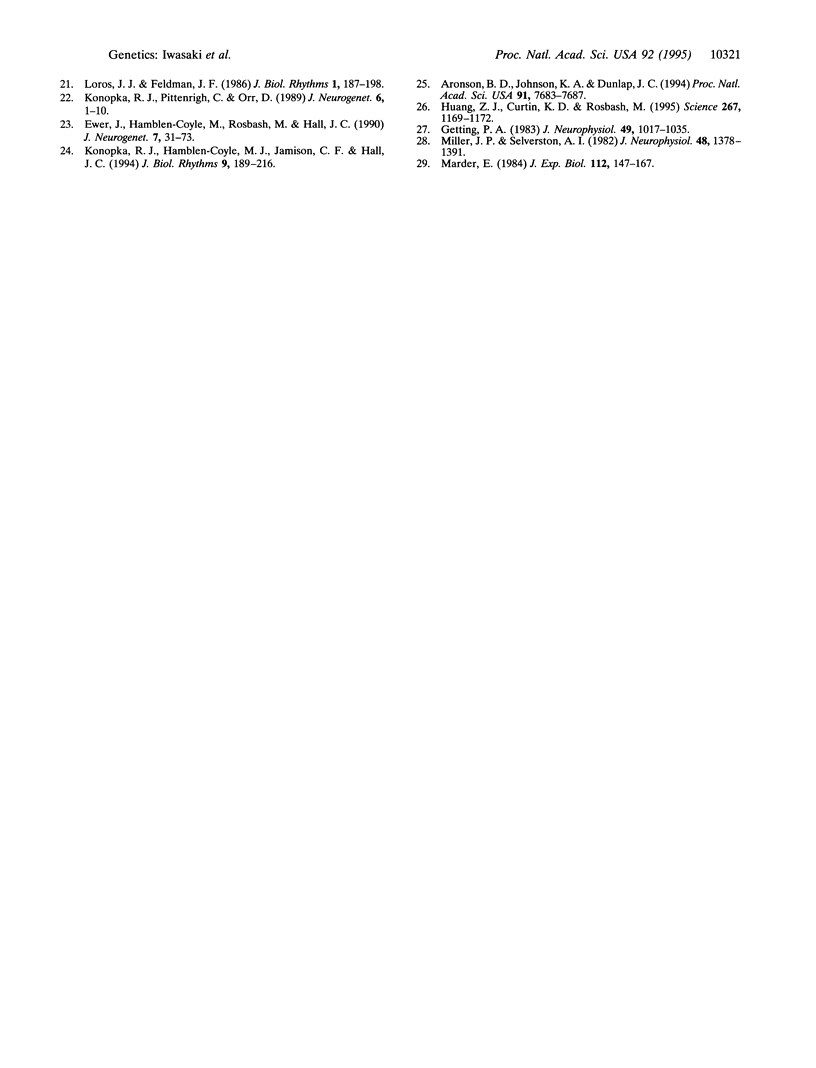
Selected References
These references are in PubMed. This may not be the complete list of references from this article.
- Aronson B. D., Johnson K. A., Dunlap J. C. Circadian clock locus frequency: protein encoded by a single open reading frame defines period length and temperature compensation. Proc Natl Acad Sci U S A. 1994 Aug 2;91(16):7683–7687. doi: 10.1073/pnas.91.16.7683. [DOI] [PMC free article] [PubMed] [Google Scholar]
- Brenner S. The genetics of Caenorhabditis elegans. Genetics. 1974 May;77(1):71–94. doi: 10.1093/genetics/77.1.71. [DOI] [PMC free article] [PubMed] [Google Scholar]
- Dekin M. S., Haddad G. G. Membrane and cellular properties in oscillating networks: implications for respiration. J Appl Physiol (1985) 1990 Sep;69(3):809–821. doi: 10.1152/jappl.1990.69.3.809. [DOI] [PubMed] [Google Scholar]
- Dunlap J. C. Genetic analysis of circadian clocks. Annu Rev Physiol. 1993;55:683–728. doi: 10.1146/annurev.ph.55.030193.003343. [DOI] [PubMed] [Google Scholar]
- Ellis R. E., Horvitz H. R. Two C. elegans genes control the programmed deaths of specific cells in the pharynx. Development. 1991 Jun;112(2):591–603. doi: 10.1242/dev.112.2.591. [DOI] [PubMed] [Google Scholar]
- Ewer J., Hamblen-Coyle M., Rosbash M., Hall J. C. Requirement for period gene expression in the adult and not during development for locomotor activity rhythms of imaginal Drosophila melanogaster. J Neurogenet. 1990 Nov;7(1):31–73. doi: 10.3109/01677069009084151. [DOI] [PubMed] [Google Scholar]
- Getting P. A. Mechanisms of pattern generation underlying swimming in Tritonia. II. Network reconstruction. J Neurophysiol. 1983 Apr;49(4):1017–1035. doi: 10.1152/jn.1983.49.4.1017. [DOI] [PubMed] [Google Scholar]
- Hall J. C. Genetics of circadian rhythms. Annu Rev Genet. 1990;24:659–697. doi: 10.1146/annurev.ge.24.120190.003303. [DOI] [PubMed] [Google Scholar]
- Horvitz H. R., Brenner S., Hodgkin J., Herman R. K. A uniform genetic nomenclature for the nematode Caenorhabditis elegans. Mol Gen Genet. 1979 Sep;175(2):129–133. doi: 10.1007/BF00425528. [DOI] [PubMed] [Google Scholar]
- Huang Z. J., Curtin K. D., Rosbash M. PER protein interactions and temperature compensation of a circadian clock in Drosophila. Science. 1995 Feb 24;267(5201):1169–1172. doi: 10.1126/science.7855598. [DOI] [PubMed] [Google Scholar]
- Katsura I., Kondo K., Amano T., Ishihara T., Kawakami M. Isolation, characterization and epistasis of fluoride-resistant mutants of Caenorhabditis elegans. Genetics. 1994 Jan;136(1):145–154. doi: 10.1093/genetics/136.1.145. [DOI] [PMC free article] [PubMed] [Google Scholar]
- Kondo T., Tsinoremas N. F., Golden S. S., Johnson C. H., Kutsuna S., Ishiura M. Circadian clock mutants of cyanobacteria. Science. 1994 Nov 18;266(5188):1233–1236. doi: 10.1126/science.7973706. [DOI] [PubMed] [Google Scholar]
- Konopka R. J., Hamblen-Coyle M. J., Jamison C. F., Hall J. C. An ultrashort clock mutation at the period locus of Drosophila melanogaster that reveals some new features of the fly's circadian system. J Biol Rhythms. 1994 Winter;9(3-4):189–216. doi: 10.1177/074873049400900303. [DOI] [PubMed] [Google Scholar]
- Konopka R. J., Pittendrigh C., Orr D. Reciprocal behaviour associated with altered homeostasis and photosensitivity of Drosophila clock mutants. J Neurogenet. 1989 Sep;6(1):1–10. doi: 10.3109/01677068909107096. [DOI] [PubMed] [Google Scholar]
- Kyriacou C. P., Hall J. C. Circadian rhythm mutations in Drosophila melanogaster affect short-term fluctuations in the male's courtship song. Proc Natl Acad Sci U S A. 1980 Nov;77(11):6729–6733. doi: 10.1073/pnas.77.11.6729. [DOI] [PMC free article] [PubMed] [Google Scholar]
- Liu D. W., Thomas J. H. Regulation of a periodic motor program in C. elegans. J Neurosci. 1994 Apr;14(4):1953–1962. doi: 10.1523/JNEUROSCI.14-04-01953.1994. [DOI] [PMC free article] [PubMed] [Google Scholar]
- Loros J. J., Feldman J. F. Loss of temperature compensation of circadian period length in the frq-9 mutant of Neurospora crassa. J Biol Rhythms. 1986 Fall;1(3):187–198. doi: 10.1177/074873048600100302. [DOI] [PubMed] [Google Scholar]
- Marder E. Roles for electrical coupling in neural circuits as revealed by selective neuronal deletions. J Exp Biol. 1984 Sep;112:147–167. doi: 10.1242/jeb.112.1.147. [DOI] [PubMed] [Google Scholar]
- Millar A. J., Carré I. A., Strayer C. A., Chua N. H., Kay S. A. Circadian clock mutants in Arabidopsis identified by luciferase imaging. Science. 1995 Feb 24;267(5201):1161–1163. doi: 10.1126/science.7855595. [DOI] [PubMed] [Google Scholar]
- Millar A. J., Straume M., Chory J., Chua N. H., Kay S. A. The regulation of circadian period by phototransduction pathways in Arabidopsis. Science. 1995 Feb 24;267(5201):1163–1166. doi: 10.1126/science.7855596. [DOI] [PubMed] [Google Scholar]
- Miller J. P., Selverston A. I. Mechanisms underlying pattern generation in lobster stomatogastric ganglion as determined by selective inactivation of identified neurons. II. Oscillatory properties of pyloric neurons. J Neurophysiol. 1982 Dec;48(6):1378–1391. doi: 10.1152/jn.1982.48.6.1378. [DOI] [PubMed] [Google Scholar]
- Rapp P. E. An atlas of cellular oscillators. J Exp Biol. 1979 Aug;81:281–306. doi: 10.1242/jeb.81.1.281. [DOI] [PubMed] [Google Scholar]
- Reuter H. Ion channels in cardiac cell membranes. Annu Rev Physiol. 1984;46:473–484. doi: 10.1146/annurev.ph.46.030184.002353. [DOI] [PubMed] [Google Scholar]
- Thomas J. H. Genetic analysis of defecation in Caenorhabditis elegans. Genetics. 1990 Apr;124(4):855–872. doi: 10.1093/genetics/124.4.855. [DOI] [PMC free article] [PubMed] [Google Scholar]
- Vitaterna M. H., King D. P., Chang A. M., Kornhauser J. M., Lowrey P. L., McDonald J. D., Dove W. F., Pinto L. H., Turek F. W., Takahashi J. S. Mutagenesis and mapping of a mouse gene, Clock, essential for circadian behavior. Science. 1994 Apr 29;264(5159):719–725. doi: 10.1126/science.8171325. [DOI] [PMC free article] [PubMed] [Google Scholar]
- Wong A., Boutis P., Hekimi S. Mutations in the clk-1 gene of Caenorhabditis elegans affect developmental and behavioral timing. Genetics. 1995 Mar;139(3):1247–1259. doi: 10.1093/genetics/139.3.1247. [DOI] [PMC free article] [PubMed] [Google Scholar]


